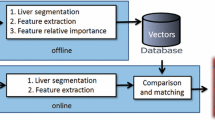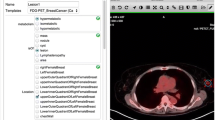Abstract
Purpose
The goal of medical case-based image retrieval (M-CBIR) is to assist radiologists in the clinical decision-making process by finding medical cases in large archives that most resemble a given case. Cases are described by radiology reports comprised of radiological images and textual information on the anatomy and pathology findings. The textual information, when available in standardized terminology, e.g., the RadLex ontology, and used in conjunction with the radiological images, provides a substantial advantage for M-CBIR systems.
Methods
We present a new method for incorporating textual radiological findings from medical case reports in M-CBIR. The input is a database of medical cases, a query case, and the number of desired relevant cases. The output is an ordered list of the most relevant cases in the database. The method is based on a new case formulation, the Augmented RadLex Graph and an Anatomy–Pathology List. It uses a new case relatedness metric \({\textit{relCase}}\) that prioritizes more specific medical terms in the RadLex tree over less specific ones and that incorporates the length of the query case.
Results
An experimental study on 8 CT queries from the 2015 VISCERAL 3D Case Retrieval Challenge database consisting of 1497 volumetric CT scans shows that our method has accuracy rates of 82 and 70% on the first 10 and 30 most relevant cases, respectively, thereby outperforming six other methods.
Conclusions
The increasing amount of medical imaging data acquired in clinical practice constitutes a vast database of untapped diagnostically relevant information. This paper presents a new hybrid approach to retrieving the most relevant medical cases based on textual and image information.






Similar content being viewed by others
References
Langs G, Hanbury A, Menze B (2013) VISCERAL: towards large data in medical imaging—challenges and directions. Med Content Based Retr Clin Decis Support 7723:92–98
Akgül CB, Rubin DL, Napel S, Beaulieu CF, Greenspan H, Acar B (2011) Content-based image retrieval in radiology: current status and future directions. J Digit Imaging 24:208–222
Alzu’bi A, Amira A, Ramzan N (2015) Semantic content-based image retrieval: a comprehensive study. J Vis Commun Image Represent 32:20–54
Liu Y, Zhang D, Lu G, Ma WY (2007) A survey of content-based image retrieval with high-level semantics. Pattern Recognit 40:262–282
Shore MW, Rubin DL, Kahn CE (2012) Integration of imaging signs into RadLex. J Digit Imaging 25:50–55
Hwang KH, Lee H, Choi D (2012) Medical image retrieval: past and present. Healthc Inform Res 18:3–9
Langlotz CP (2006) RadLex: a new method for indexing online educational materials. Radiographics 26:1595–1597
Marwede D, Schulz T, Kahn T (2008) Indexing thoracic CT reports using a preliminary version of a standardized radiological lexicon (RadLex). J Digit Imaging 21:363–370
Rubin DL (2008) Creating and curating a terminology for radiology: ontology modeling and analysis. J Digit Imaging 21:355–362
Rada R, Mili H, Bicknell E, Bletner M (1989) Development and applications of a metric on semantic nets. IEEE Trans Syst Man Cybern 1:17–30
Leacock C, Chodorow M (1998) Combining local context and WordNet similarity for word sense identification. WordNet An Electron Lex Database 49:265–283
Lee W-N, Shah N, Sundlass K, Musen M (2008) Comparison of ontology-based semantic-similarity measures. AMIA Annu Symp Proc 6:384–388
Al-Mubaid H, Nguyen HA (2006) A cluster-based approach for semantic similarity in the biomedical domain. Annu Int Conf IEEE Eng Med Biol-Proc 1:2713–2717
Sánchez D, Batet M (2011) Semantic similarity estimation in the biomedical domain: an ontology-based information-theoretic perspective. J Biomed Inform 44:749–759
Pedersen T, Pakhomov SVS, Patwardhan S, Chute CG (2007) Measures of semantic similarity and relatedness in the biomedical domain. J Biomed Inform 40:288–299
Seco N, Veale T, Hayes J (2004) An intrinsic information content metric for semantic similarity in WordNet. ECAI 16:1089–1094
Zhou Z, Wang Y, Gu J (2008) A new model of information content for semantic similarity in WordNet. Second Int Conf Futur Gener Commun Netw Symp 1:85–89
Sánchez D, Batet M, Isern D (2011) Ontology-based information content computation. Knowledge-Based Syst 24:297–303
Li Y, Bandar ZA, McLean D (2003) An approach for measuring semantic similarity between words using multiple information sources. IEEE Trans Knowl Data Eng 15:871–882
Batet M, Sánchez D, Valls A (2011) An ontology-based measure to compute semantic similarity in biomedicine. J Biomed Inform 44:118–125
Rubner Y, Tomasi C, Guibas LJ (2000) The earth mover’s distance as a metric for image retrieval. Int J Comput Vis 40:99–121
Batet M, Erola A, Sánchez D, Castellà-Roca J (2013) Utility preserving query log anonymization via semantic microaggregation. Inf Sci 242:49–63
Terrovitis M, Mamoulis N, Kalnis P (2008) Privacy-preserving anonymization of set-valued data. Proc VLDB Endow 1:115–125
Kurtz C, Gançarski P, Passat N, Puissant A (2013) A hierarchical semantic-based distance for nominal histogram comparison. Data Knowl Eng 87:206–225
Kurtz C, Depeursinge A, Napel S, Beaulieu CF, Rubin DL (2014) On combining image-based and ontological semantic dissimilarities for medical image retrieval applications. Med Image Anal 18:1082–1100
Spanier AB, Joskowicz L (2015) Medical case-based retrieval of patient records using the RadLex hierarchical lexicon. In: Multimodal retrieval in the medical domain. pp 129–138
del–Toro OA, Hanbury A, Langs G, Foncubierta–Rodríguez A, Müller H (2015) Overview of the VISCERAL retrieval benchmark 2015. In: Multimodal retrieval in the medical domain. pp 115–123
Schroeder V (2006) Quasi-metric and metric spaces. Conform Geom Dyn Am Math Soc 10:355–360
Lord PW, Stevens RD, Brass A, Goble CA (2003) Investigating semantic similarity measures across the Gene Ontology: the relationship between sequence and annotation. Bioinformatics 19:1275–1283
Batet M, Erola A, Sánchez D, Castellà-Roca J (2014) Semantic anonymisation of set-valued data. In: ICAART. pp 102–112
Spanier AB, Joskowicz L (2014) Rule-based ventral cavity multi-organ automatic segmentation in CT scans. In: International MICCAI workshop on medical computer vision. pp 163–170
Kurtz C, Beaulieu CF, Napel S, Rubin DL (2014) A hierarchical knowledge-based approach for retrieving similar medical images described with semantic annotations. J Biomed Inform 49:227–244
Voorhees EM, Harman DK (2005) TREC: Experiment and evaluation in information retrieval. Cambridge MIT Press, Cambridge
Chen H, Karger DR (2006) Less is more: probabilistic models for retrieving fewer relevant documents. In: Proceedings of the 29th annual international ACM SIGIR conference on research and development in information retrieval. pp 429–436
Pirró G, Euzenat J (2010) A feature and information theoretic framework for semantic similarity and relatedness. In: International semantic web conference. pp 615–630
Hirst G, St-Onge D (1998) Lexical chains as representations of context for the detection and correction of malapropisms. WordNet An Electron Lex Database 305:305–332
Rogers LJ (1991) Determination of the number and waveshapes of event related potential components using comparative factor analysis. Int J Neurosci 56:219–246
Choudhari M, Pedersen T (2012) Extending the hirst and st-onge measure of semantic relatedness for the unified medical language system. Dissertation University of Minnesota
Acknowledgments
This research was partially funded by Grant 53681 from the Israeli Ministry of Science and Technology.
Author information
Authors and Affiliations
Corresponding author
Ethics declarations
Conflict of interest
None of the authors has any conflict of interest. The authors have no personal financial or institutional interest in any of the materials, software or devices described in this article.
Protection of human and animal rights statement
No animals or humans were involved in this research. All scans were anonymized before delivery to the researchers.
Rights and permissions
About this article
Cite this article
Spanier, A.B., Cohen, D. & Joskowicz, L. A new method for the automatic retrieval of medical cases based on the RadLex ontology. Int J CARS 12, 471–484 (2017). https://doi.org/10.1007/s11548-016-1496-y
Received:
Accepted:
Published:
Issue Date:
DOI: https://doi.org/10.1007/s11548-016-1496-y




